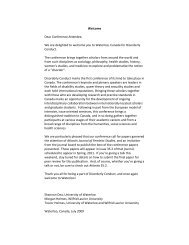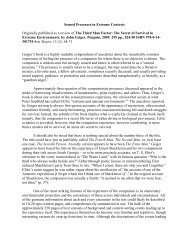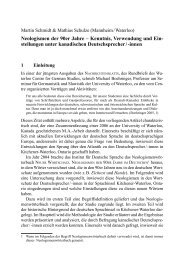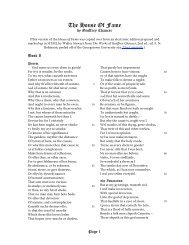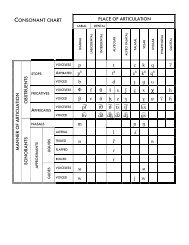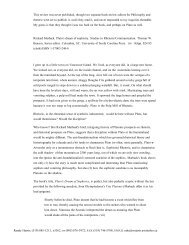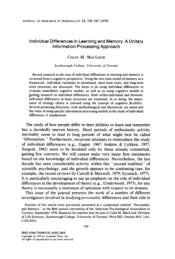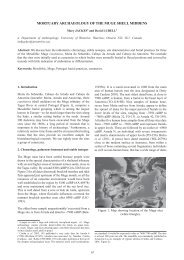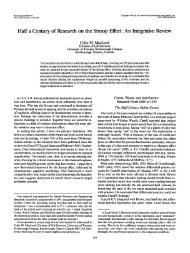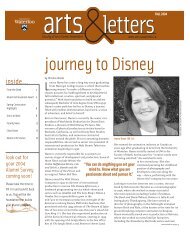The mid seventeenth century collapse of Iroquoian Ontario:
The mid seventeenth century collapse of Iroquoian Ontario:
The mid seventeenth century collapse of Iroquoian Ontario:
You also want an ePaper? Increase the reach of your titles
YUMPU automatically turns print PDFs into web optimized ePapers that Google loves.
M. JackeS<br />
350<br />
<strong>The</strong> Neutral were active traders. <strong>The</strong>y made war only with some Algonquian speaking<br />
peoples to the west and were neutral (Champlain, Biggar, 1922-36, iii, p. 100; iv, p. 283; vi,<br />
p. 249; JR, 21, p. 193) in the conflicts among other <strong>Iroquoian</strong>s, although Sagard (1939, p. 151,<br />
157) recorded that some Huron wished to wage war on the Neutral. No doubt their<br />
geographical position between the Huron and the Seneca (fig. 2) with regard to trade, was a<br />
significant factor in this neutrality, which has been ascribed to a variety <strong>of</strong> elements such as<br />
maize and tobacco (which they grew, Sagard, 1939, p. 158), black squirrel furs, the quality <strong>of</strong><br />
the chert locally available to them, without any certainty as to which were <strong>of</strong> any, or <strong>of</strong><br />
primary, importance (see e.g. Rotstein, 1988). Noble (1984) has suggested that this neutrality<br />
functioned to provide a type <strong>of</strong> sacred sanctuary.<br />
<strong>The</strong> Neutral were said to be powerful and strong and warlike (Leclercq, 1881, i, p. 266),<br />
while the Huron Nation was described as “ti<strong>mid</strong>” (fort craintive in the original <strong>seventeenth</strong><br />
<strong>century</strong> French), fleeing in the face <strong>of</strong> the enemy (JR, 10, p. 95).<br />
<strong>The</strong> nature <strong>of</strong> contact with Europeans<br />
Although there had been European fishermen and whalers in Canada since the 15th<br />
<strong>century</strong>, there is no reason to believe that they had direct contact with the <strong>Ontario</strong> <strong>Iroquoian</strong><br />
nations. French exploration <strong>of</strong> the St. Lawrence River as far as the island <strong>of</strong> Montreal revealed<br />
the existence <strong>of</strong> <strong>Iroquoian</strong> settlements along the river in 1534-6 and 1542-3. However, in 1603<br />
Samuel de Champlain recorded that the St. Lawrence was depopulated (the reasons for this<br />
are debated, see e.g. Jamieson, 1990; Trigger, 1987, p. 215-228; Ramsden, 1990, p. 383). Those<br />
who had lived in the area <strong>of</strong> Montreal, or perhaps only the women and children, might have<br />
joined Huron from southern and eastern <strong>Ontario</strong> who moved north and west and consolidated<br />
in what had became Huronia by the early 17th <strong>century</strong> (fig. 2). We therefore have no<br />
record <strong>of</strong> European contact along the upper reaches <strong>of</strong> the St. Lawrence in the last half <strong>of</strong> the<br />
16th <strong>century</strong>, and certainly expect none further to the west in <strong>Ontario</strong>. Nevertheless, European<br />
trade goods began to appear in Huron ossuaries towards the end <strong>of</strong> the 16th <strong>century</strong>, even<br />
before the <strong>Iroquoian</strong> consolidation into Huronia (e.g. for example, iron axes and trade beads<br />
at Kleinburg: Turgeon, 1998; Hancock et al., 1994). Thus, there were possible routes <strong>of</strong> transmission<br />
for diseases imported from Europe prior to direct contact.<br />
<strong>The</strong> first direct European contact for the Huron population at large was with Etienne<br />
Brûlé who was sent by Samuel de Champlain in 1610 to travel west from Quebec. For the rest<br />
<strong>of</strong> his life he travelled with or lived with <strong>Ontario</strong> First Nations peoples and it is presumed<br />
that he spent most <strong>of</strong> his time among or with the Huron. In September 1615, Brûlé must have<br />
passed briefly through the territory <strong>of</strong> the Neutral Nation, guided by Hurons. It is very likely<br />
that he later spent some time with the Neutral: unfortunately, nothing is recorded <strong>of</strong> what he<br />
learned, although Father Joseph de la Roche-Daillon in 1626 said he wished to go to the<br />
Neutral country specifically because Brûlé reported wonderful things about it (LeClercq,<br />
1881, i, p. 264; Butterfield, 1898, p. 111-112 assumes that Brûlé had spent the previous winter<br />
with the Neutral).



